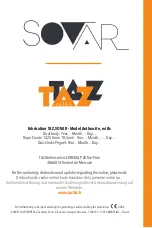
16
17
PWORKING PRINCIPLE:
The adjustment device is a type 2 manually operated descending device. It also has automatic locking when
the operator releases the descent handle: When an operator hangs a person on the equipment, controlling
the free rope with one hand, the tool tilts due to the weight. The rope pivots the mobile sheave, creating a
clamping effect at the opposite end, between the two sheaves
(diagram B)
. The person is therefore blocked
in the hands-free position, the operator will have to take action to lower them. To release the locking effect,
firmly grasp the free end of the rope, open the handle and press it in the same direction.
WARNING:
Always hold on the end of the free rope when pushing down on the handle. The speed descent
is controlled thanks to keeping the hand on the free rope. It is mandatory to practise using the handle release
for braking/locking purposes. Once the first descend takes place, the free rope becomes the descending rope
and the descending rope becomes the free rope. Attach the second person and use the second handle while
respecting the above-mentioned indications.
WHEN NECESSARY: SETTING UP THE ROPE:
(DIAGRAM C, D AND E).
Open the two mobile plates. Pass the rope through the first space. Pass the rope in the first longitudinal space
between the 2 sheaves then in the second longitudinal space between the 2 other sheaves. Close the two
mobile plates while maintaining the correct positioning of the closure presented in the
D and E diagrams
.
The free ends of the rope come out on each side of the device. The rope in the middle serves to manage the
slack between the two parts of the device
(see diagrams E2 and K)
.
To remove the rope, the user opens the mobile plate by pressing down on the push button, and by rotating the
mobile plate so that it opens the longitudinal space between the sheaves.
When starting to use SOVAR:
> Check that the spring-based locking push button is correctly engaged in the locking hole of the mobile
plate, and that it locks it firmly
(diagram E1)
> Check that the quick-links are well connected with the two parts of the device and under the same connector.
Also check that the quick links are properly connected on the 2 parts of the device and on the same connec-
tor and check that they are properly locked
(diagram E3)
> Always check if the device blocks if/when the ropes are loaded on one side or another.
WARNING! PAY ATTENTION TO AVOID CLOSING THE MOBILE PLATES INCORRECTLY
(diagram E2)
ANCHORS:
The anchoring of the system must meet good practice requirements, rules and regulations afferent to
rescue activities EN 795.
Be aware to not worry descent witch the connection of the device to the anchor.
OPERATIONAL TEST
For each use, the user must test the locking effect of the SOVAR device.
If the device does not lock, do not use it. Immediately contact the manufacturer – TAZ. The operation of the
device is optimal when the usage conditions are normal, with low humidity, average temperature (5°C to
25°C), away from sources of dust and grease. When conditions are not favourable (extreme heat, rain, frost,
dust, grease, etc.), there is a risk of losing control while descending, or of damaging the rope. Additional
precautions (speed reduction, braking carabiner) should be taken.
OPERATION:
Descending: once the operational tests are complete, hold the free rope coming out of the device with one
hand, and open and pull the handle of the SOVAR device with the other hand. The desired speed will be
attained by adjusting the traction on the handle, and by braking with the other hand on the free rope coming
out of the device.
WARNING
Do not exceed a speed of 1m/s, otherwise the stainless steel of the sheaves can overheat and alter the friction,
and therefore the locking effect, or damage the support.
Always hold and brake on the free rope coming out of the device
(diagrams F, G, H, I)
when performing
manoeuvres and movements.
When overgripping the open handle, the user cancels the braking effect of the SOVAR device. It is essential
to practise releasing the handle.
WARNING:
This double action can occur accidentally; pay special attention to the area of the push button.
ADDITIONAL GENERAL INFORMATION:
Life Cycle, Retirement:
The device must also be checked by a competent inspector at least every twelve months (annual inspection);
the inspector should fill in the identification sheet available in the annex, or a copy, with the model and its
identification details. (Device number, purchase date, year of manufacture, date of the first use, exceptional
events, history of inspections, etc.) According to the intensity of the use, and factors such as ambient condi-
tions or regulations, the inspection frequency may increase.
Retire if:
> The device must be retired if it is subjected to exceptional circumstances, overloaded or dynamically loaded
(a force over 300kg, fall arrest), used inadequately (disregarding the above-mentioned chapters), if falling
from height to the ground, etc.
> Any defect, crack or other sign of wear and tear (see checks, points to check
p.14, 15
)
> If you do not know the complete history of the tool or if you have doubts regarding its efficiency, stop using
the device and retire it.
> If the use of the device becomes obsolete (due changes in legislation, technical regulations or due to incom-
patibility with other devices, etc.), retire the device.
> 30 years after the date of manufacture for the metal parts, 10 years for the rope. In order to avoid any future
reuse, the retirement needs to be performed by means of a destruction tool.
> All modifications, part changes, and repairs are forbidden outside the TAZ workshops. The rope only can be
changed and supplied by the TAZ house.
ENGLISH































